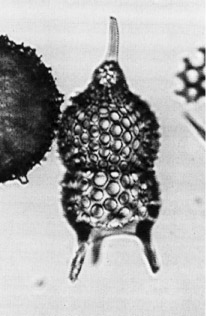 Thyrsocyrtis
(Thyrsocyrtis) robusta Riedel and Sanfilippo
Thyrsocyrtis
(Thyrsocyrtis) robusta Riedel and Sanfilippo Thyrsocyrtis
(Thyrsocyrtis) robusta Riedel and Sanfilippo
Thyrsocyrtis
(Thyrsocyrtis) robusta Riedel and SanfilippoThyrsocyrtis hirsuta robusta Riedel and Sanfilippo, 1970, p.526, pl.8, fig.1
Thyrsocyrtis (Thyrsocyrtis) robusta Riedel and Sanfilippo, Sanfilippo and Riedel, 1982, p.174, pl.1, fig.5
Similar in general form to T. hirsuta, but larger, and differing also in the following respects: shell surface pronouncedly roughened by thorns arising mainly from the junctions of intervening bars; horn usually long; both abdomen and thorax conspicuously inflated, and lumbar stricture consequently deep; feet straight, or slightly curved inward or outward, and often terminally fluted and perforated (Sanfilippo and Riedel, 1982).
Based on 20 specimens. Length (excluding horn and feet) 160-250 µm, maximum breadth 115-160 µm (Sanfilippo and Riedel, 1982).
T. robusta differs from T. hirsuta and T. tarsipes in larger size, more pronounced lumbar stricture and thorny surface (Sanfilippo et al., 1985).
T. robusta has a hemispherical thorax, inflated abdomen, well defined lumbar stricture and a very rough surface. The feet are straight, or curved with convexity inward or outward, pointed or ragged terminally. Through its short stratigraphic range the only variation observed is in the degree of inflation of the thorax and the abdomen, and the development of the horn and thorns on the shell (Sanfilippo et al., 1985).
T. robusta is restricted to the early part of the early middle Eocene in middle to low paleolatitudes (Indian, Pacific, Atlantic, Gulf of Mexico and the Caribbean). Its morphotypic first appearance lies within the Theocotyle cryptocephala Zone. Its morphotypic last appearance lies within the Thyrsocyrtis triacantha Zone.
T. robusta appears to be an evolutionary offshoot from the lineage connecting T. hirsuta and T. tensa.